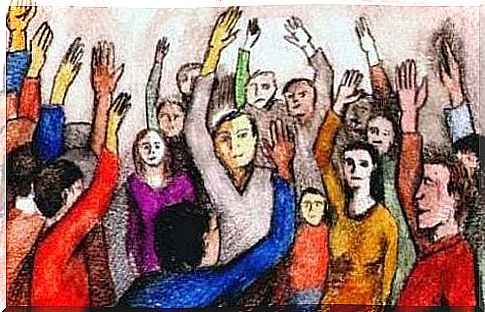Emotions That Cause Aggression
.Emotions are always the precursors of behavior. They trigger physiological responses and spur dedicated mental structures to link memories to emotions. In any case, the core of the story remains this: emotions motivate behaviour. So what are emotions that cause aggression?
Emotions elicit different types of behavior. This can even lead to violence. To be exact: a combination of emotions can provoke aggression in us. All the emotions themselves make us not aggressive.
In general, we recognize an emotion as a psychophysiological response that people experience and feel individually. However, thanks to empathy, our emotions can become ‘contagious’. That is, others will start to feel the same as you.
This also happens within groups. A group of people can experience the same kind of emotion together. They may feel guilty or angry towards another group. This empathy is the starting point for understanding emotions that cause aggression.
Emotions that cause aggression according to the ANCODI hypothesis
The ANCODI hypothesis owes its name to the following English words: anger (anger), contempt (contempt) and disgust (disgust). According to this hypothesis, the aforementioned emotions lead to the use of violence. Hostility and violence are each the result of hatred and anger.
People use stories to spread emotions. Stories can be a way to turn an emotion of one person into a group emotion. A strong example of this is hate speech against a minority or other group seen as a rival or enemy.

It implies that a past event or historical story results in outrage. Which in turn provokes anger. The group re-evaluates these events in the present from a position of perceived moral superiority. As a result, the other group is quickly seen as morally inferior.
This results in contempt and scorn. The other group is seen as separate and deserves to be avoided and rejected. In extreme cases, an entire group can be completely eliminated. The emotions that cause aggression are expressed through a 3-step process. We explain these below.
Outrage based on anger
The first phase revolves around anger. Anger is an emotion that we express through resentment and irritability. The most noticeable expressions are usually facial expressions, body language and physiological reactions (for example, palpitations or tremors). In some cases, people express their anger through public violence. Uncontrollable anger can have a negative effect on your quality of life.
It starts like this: certain events lead to the perception of injustice. These same events provoke people to point out a guilty party (or scapegoat). Whether that is a single person or a group of people. In these cases, people believe that the culprit is endangering the prosperity of ‘our’ group or ‘our’ lifestyle. These thoughts are then charged with a sense of anger which is then directed at the guilty party.
Moral superiority based on contempt
In the second stage, contempt is involved in the process. Contempt is an intense feeling of lack of respect or recognition, accompanied by complete distaste for something or someone. This often results in rejecting and humiliating another. Also, the ability and moral integrity of the other is often questioned.
To feel contempt for another person or group is to feel morally superior to that other party. A person who feels contempt for another looks down on him. The individual is seen as inferior.
Groups re-explain the situations and events from the first phase. This evaluation of past events is made from a supposedly morally superior standpoint. That means they see the ‘guilty’ group as morally inferior. That, in turn, leads to a feeling of contempt for the troop in question. This leads to a vicious circle.

Elimination out of disgust
In the final stage, disgust begins to play a role. The perception of contamination and disease causes this fundamental primal feeling. It is a general concept: both the signs of this and the causes are universal. Disgust has many similar causes, such as a rotting process (think of the smell and how it looks). It is an emotion related to morality. It is therefore often used to justify beliefs and applications of ethics.
In this phase, the previous events are again evaluated and a conclusion is reached. This conclusion is very simple: we must remove ourselves from the guilty group (or person). Another — often much more violent — option is for the guilty party to be eliminated. However, this is a more extreme outcome. In such a case, people depend on disgust to spread their ideology sufficiently.
As you can see, the combination of these three emotions can have disastrous effects. The emotions that cause aggression are based on distorted perceptions and cause bad conclusions and — in extreme cases — hostile behavior. That is why it is very important to train and maintain your emotional intelligence.









